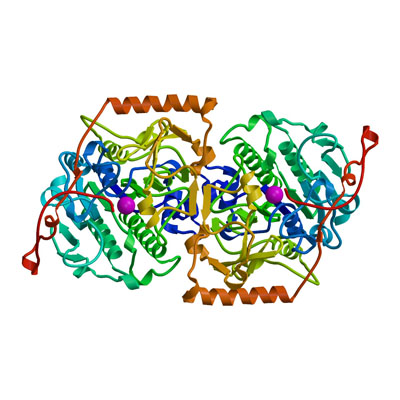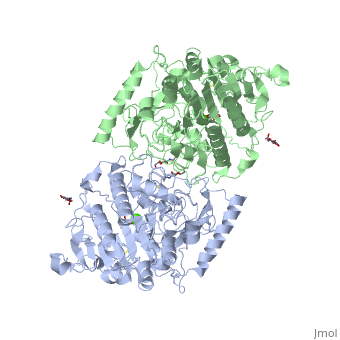Molecular Playground/Human Galactosamine-6-sulfatase
From Proteopedia
One of the CBI Molecules being studied in the University of Massachusetts Amherst Chemistry-Biology Interface Program at UMass Amherst and on display at the Molecular Playground.
Contents |
Human galactosamine-6-sulfatase (GALNS)
The human lysosomal galactosamine-6-sulfatase (E.C. 3.1.6.4), also known as N-acetylgalactosamine-6-sulfatase, removes sulfate groups from a terminal N-acetyl-galactose-6-sulfate (or galactose-6-sulfate) in mucopolysaccharides such as keratan sulfate and chondroitin-6-sulfate Defects in GALNS lead to accumulation of mucopolysaccharides, resulting in the development of the lysosomal storage disease mucopolysaccharidosis 4A, also known as Morquio A disease[1].
|
GALNS active site
Sulfatases require maturation of a side chain residue into a catalytic nucleophile. In GALNS, the polypeptide chain encodes a cysteine at residue 79 at the start of the motif CXPXRXXL. The formylglycine generating enzyme recognizes this motif and converts Cys79 into a formylglycine aldehyde[2]. Hydration of the aldehyde by a water molecule generates the gem diol nucleophile dihydroxyalanine, which ligates Ca2+ in the active site. The spinning protein is human human lysosomal galactosamine-6-sulfatase with GalNac in the a represented by spheres.
Additional Resources
For additional information, see: Metabolic Disorders
References:
[1]Muenzer, J. Neufeld, E.F. The Mucopolysaccharidoses: In The Metabolic Basis of Inherited Disease, 8th ed. McGraw-Hill: Medical Publishing Division, 2001; Vol. 3 p 3431-3452.
[2] K. von Figura, V. Gieselmann, J. Jaeken in The Metabolic and Molecular Bases of Inherited Disease, Vol. III, 8th ed. (Ed.: C. R. Scriver), McGraw-Hill, New York, 1999, p. 3695
Molecular Playground banner: Human lysosomal galactosamine-6-sulfatase
Proteopedia Page Contributors and Editors (what is this?)
Yadilette Rivera-Colon, Ralph A. Francescone III, David Canner, Lynmarie K Thompson


